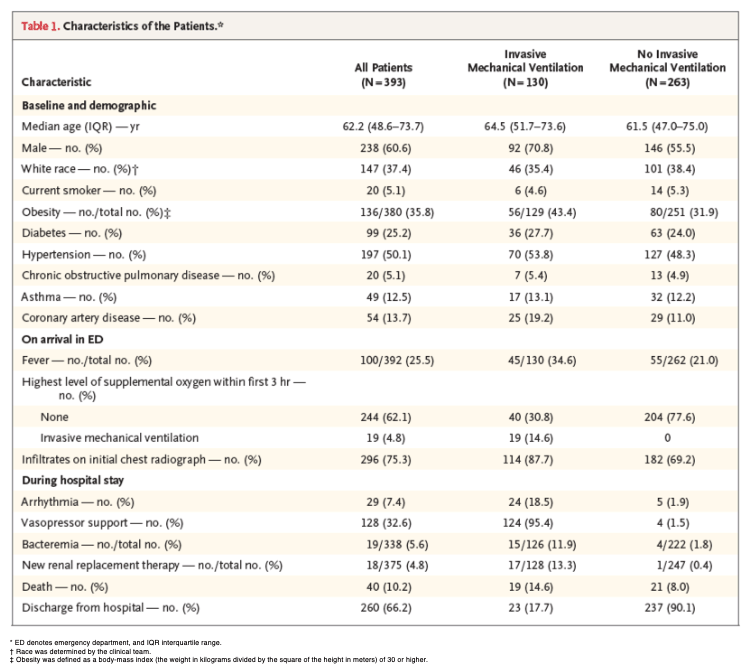| |
Clinical Characteristics of Covid-19 in New York City
|
| |
| |
Download the PDF here
April 17, 2020
NEJM DOI: 10.1056/NEJMc2010419
To the Editor:
The world is in the midst of the coronavirus disease 2019 (Covid-19) pandemic,1,2 and New York City has emerged as an epicenter. Here, we characterize the first 393 consecutive patients with Covid-19 who were admitted to two hospitals in New York City.
This retrospective case series includes adults 18 years of age or older with confirmed Covid-19 who were consecutively admitted between March 5 (date of the first positive case) and March 27, 2020, at an 862-bed quaternary referral center and an affiliated 180-bed nonteaching community hospital in Manhattan. Both hospitals adopted an early-intubation strategy with limited use of high-flow nasal cannulae during this period. Cases were confirmed through reverse-transcriptase–polymerase-chain-reaction assays performed on nasopharyngeal swab specimens. Data were manually abstracted from electronic health records with the use of a quality-controlled protocol and structured abstraction tool (details are provided in the Methods section in the Supplementary Appendix, available with the full text of this letter at NEJM.org).
Among the 393 patients, the median age was 62.2 years, 60.6% were male, and 35.8% had obesity (Table 1). The most common presenting symptoms were cough (79.4%), fever (77.1%), dyspnea (56.5%), myalgias (23.8%), diarrhea (23.7%), and nausea and vomiting (19.1%) (Table S1 in the Supplementary Appendix). Most of the patients (90.0%) had lymphopenia, 27% had thrombocytopenia, and many had elevated liver-function values and inflammatory markers. Between March 5 and April 10, respiratory failure leading to invasive mechanical ventilation developed in 130 patients (33.1%); to date, only 43 of these patients (33.1%) have been extubated. In total, 40 of the patients (10.2%) have died, and 260 (66.2%) have been discharged from the hospital; outcome data are incomplete for the remaining 93 patients (23.7%).

Patients who received invasive mechanical ventilation were more likely to be male, to have obesity, and to have elevated liver-function values and inflammatory markers (ferritin, d-dimer, C-reactive protein, and procalcitonin) than were patients who did not receive invasive mechanical ventilation. Of the patients who received invasive mechanical ventilation, 40 (30.8%) did not need supplemental oxygen during the first 3 hours after presenting to the emergency department. Patients who received invasive mechanical ventilation were more likely to need vasopressor support (95.4% vs. 1.5%) and to have other complications, including atrial arrhythmias (17.7% vs. 1.9%) and new renal replacement therapy (13.3% vs. 0.4%).
Among these 393 patients with Covid-19 who were hospitalized in two New York City hospitals, the manifestations of the disease at presentation were generally similar to those in a large case series from China1; however, gastrointestinal symptoms appeared to be more common than in China (where these symptoms occurred in 4 to 5% of patients). This difference could reflect geographic variation or differential reporting. Obesity was common and may be a risk factor for respiratory failure leading to invasive mechanical ventilation.3 The percentage of patients in our case series who received invasive mechanical ventilation was more than 10 times as high as that in China; potential contributors include the more severe disease in our cohort (since testing and hospitalization in the United States is largely limited to patients with more severe disease) and the early-intubation strategy used in our hospitals. Regardless, the high demand for invasive mechanical ventilation has the potential to overwhelm hospital resources. Deterioration occurred in many patients whose condition had previously been stable; almost a third of patients who received invasive mechanical ventilation did not need supplemental oxygen at presentation. The observations that the patients who received invasive mechanical ventilation almost universally received vasopressor support and that many also received new renal replacement therapy suggest that there is also a need to strengthen stockpiles and supply chains for these resources.
Parag Goyal, M.D.
Justin J. Choi, M.D.
Laura C. Pinheiro, M.P.H., Ph.D.
Edward J. Schenck, M.D.
Ruijun Chen, M.D.
Assem Jabri, M.D.
Michael J. Satlin, M.D.
Thomas R. Campion, Jr., Ph.D.
Musarrat Nahid, M.Sc.
Joanna B. Ringel, M.P.H.
Katherine L. Hoffman, M.S.
Mark N. Alshak, B.A.
Han A. Li, B.A.
Graham T. Wehmeyer, B.S.
Mangala Rajan, M.B.A.
Evgeniya Reshetnyak, Ph.D.
Nathaniel Hupert, M.D., M.P.H.
Evelyn M. Horn, M.D.
Fernando J. Martinez, M.D.
Roy M. Gulick, M.D., M.P.H.
Monika M. Safford, M.D.
Weill Cornell Medicine, New York, NY
pag9051"at"med.cornell.edu
Supported by New York–Presbyterian Hospital and Weill Cornell Medicine, including the Clinical and Translational Science Center (supported by a grant [UL1 TR000457] from the National Institutes of Health) and Joint Clinical Trials Office of Weill Cornell Medicine.
|
|
| |
| |
|
|
|